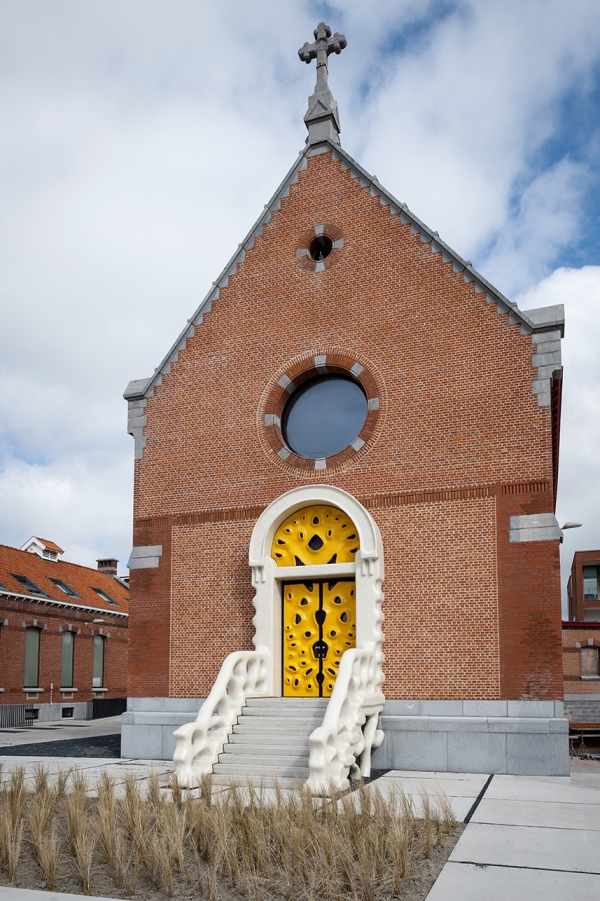IMAGROD
Toegevoegd op 19 januari 2015 door sne

Afbeelding toegevoegd door sne
Kunstenaar:
Nick Ervinck
Nick Ervinck
Opschrift:
IMAGROD, 2010-2012
polyrethane, polyester
600 x 400 x 300 cm
IMAGROD, 2010-2012
polyrethane, polyester
600 x 400 x 300 cm
Plaatsbeschrijving:
Oostende - Oud Militair Hospitaal
Oostende - Oud Militair Hospitaal
IMAGROD is an ornamental yellow sculpture, installed at the front of the chapel of the military hospital in Ostend. Referring to the giant 'gates of paradise' made by the Renaissance sculptor Lorenzo Ghiberti, Nick Ervinck interprets this gate as a trespass between the manual and the digital. Though exploring the boundaries between sculpture, architecture and design, Nick Ervinck pays great respect to this cultural heritage. His design is inspired on the authentic doors of this chapel, but realised with contemporary materials (polyester).
The structure of IMAGROD seems to be the result of a spontaneous, natural erosion process (think for instance on how seawater hollows out rocks). Yet, the shining yellow finishing gives the sculpture the look of an artefact. Moreover, Nick Ervinck refers to the fauna and flora, and specific to the sea with its hidden networks and corals. By doing so, he is indebted to Hans Arp and Henry Moore, two sculptors who introduced the organic and the void in their constructions.
The work of Nick Ervinck runs parallel with the current architectural discourse concerning blobs and boxes. Resulting out of geometric and hard shapes, erratic, biomorphic and soft shapes come into being by using the computer. This evolution from the geometric to the organic is only possible by a control over the software. In IMAGROD, the doors and window sills can be interpreted as blobs, while the chapel represents the box. The result of this game is a tension between old and new, between history and future.
IMAGROD is an ornamental yellow sculpture, installed at the front of the chapel of the military hospital in Ostend. Referring to the giant 'gates of paradise' made by the Renaissance sculptor Lorenzo Ghiberti, Nick Ervinck interprets this gate as a trespass between the manual and the digital. Though exploring the boundaries between sculpture, architecture and design, Nick Ervinck pays great respect to this cultural heritage. His design is inspired on the authentic doors of this chapel, but realised with contemporary materials (polyester). The structure of IMAGROD seems to be the result of a spontaneous, natural erosion process (think for instance on how seawater hollows out rocks). Yet, the shining yellow finishing gives the sculpture the look of an artefact. Moreover, Nick Ervinck refers to the fauna and flora, and specific to the sea with its hidden networks and corals. By doing so, he is indebted to Hans Arp and Henry Moore, two sculptors who introduced the organic and the void in their constructions. The work of Nick Ervinck runs parallel with the current architectural discourse concerning blobs and boxes. Resulting out of geometric and hard shapes, erratic, biomorphic and soft shapes come into being by using the computer. This evolution from the geometric to the organic is only possible by a control over the software. In IMAGROD, the doors and window sills can be interpreted as blobs, while the chapel represents the box. The result of this game is a tension between old and new, between history and future.
